Content
Garlic rots in the garden due to a variety of reasons: from "traditional" fungal diseases to violations of agricultural technology. In some cases, the situation can be corrected by applying the necessary means. In others, it is easier to dig up the ridge, destroy all the plants and plant the spice in another place.
Why does garlic rot in the garden
It is usually believed that garlic rots at the root due to disease. And they take appropriate measures. This is very often the case. But we must also take into account the impact of pests and completely subtle factors, which are often overlooked. "Non-contagious" reasons why garlic rots:
- High acidity of the soil, onions prefer alkaline or neutral soil.
- The proximity of groundwater, in this case, in the spring, the garlic planted before winter rots. Groundwater rises during the melting of snows and “creeps up” to the planted teeth.
- Formation of an airtight crust on the surface of the earth. Plants love loose soil. If you do not loosen after each watering, the heads of garlic often rot.
- The already spoiled slices were planted, it is not worth saving on seed material.
- Conflict with neighboring plants.
- Lack of nitrogen in the soil, due to which the root system does not develop.
Sometimes winter garlic rots in the spring right in the garden due to severe frosts. If it was not planted deeply or not well enough covered. Frozen slices begin to rot immediately after warming.
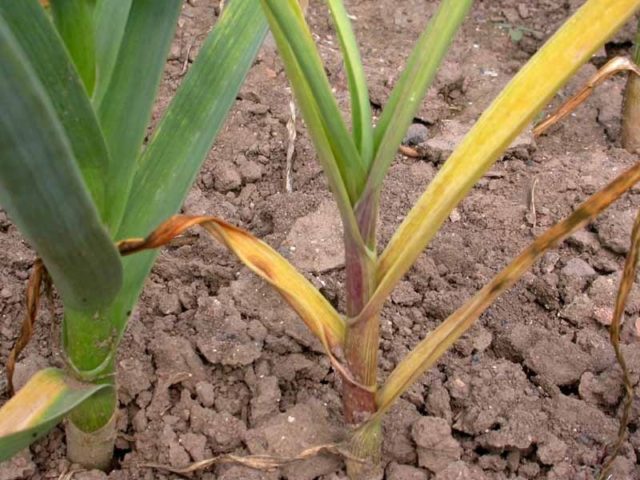
The most conspicuous sign of garlic disease with any kind of rot is yellowed leaves.
Diseases
Garlic rot is caused by microorganisms anyway. Even if the lobule died due to frost, its further decomposition occurs due to bacteria. Infectious reasons why garlic rots in the ground:
- fusarium;
- sclerotinosis;
- aspergillosis;
- gray rot;
- bacteriosis.
The main cause of disease is fungi. Bacteria infect already matured heads laid for storage. Because of bacteria, garlic in the soil rarely rots and only under very warm weather conditions.
Fusarium
The popular name is bottom rot. At the initial stage, it is difficult to notice, since the garlic starts to rot from the roots. Further, the infection passes to the bulb. The bases, bottoms, become light pink or yellow. The teeth dry up and mummify.

Fusarium leaves begin to turn yellow even at the stage of dying off of the roots
In garlic, the main cause of root rot disease is waterlogged soil at high air temperatures. These are ideal conditions for the reproduction of most microorganisms. Healthy bulbs become infected with rot when stored with sick ones or directly in the ground. If the latter has not been disinfected.
Sclerotiniasis
Or white rot. Infection occurs through the soil during the growing season. Disease is possible during storage.White rot is a fungus that is quite capable of moving from an infected head of garlic to a healthy one.
The first sign of the appearance of a fungus during the growing season is the yellowing of the upper part of the leaves, which die off with the development of the disease. Further, the bulb begins to rot. The lobules become watery. A dense white mycelium forms on the roots.
Factors predisposing to the disease are high humidity and low soil temperature, no more than 20 ° C. Because of these conditions, garlic planted in the fall has the greatest chances of rotting from sclerotinosis.
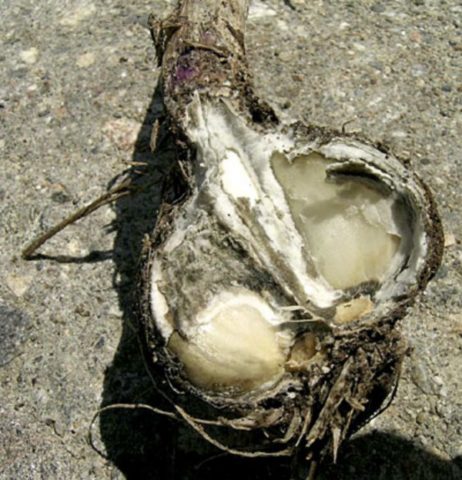
White rot affects not only the roots and surface husks, it also penetrates directly into the pulp of the onion
Aspergillosis
Better known as black mold. Already mature heads of garlic stored in storage rot. The spread begins with one slice and then spreads to the entire bulb. When in contact with other bulbs, mold spreads to them.
When infected with aspergillosis, the lobules soften. Gradually, the mold replaces the clove of garlic and only black dust remains in the husk.
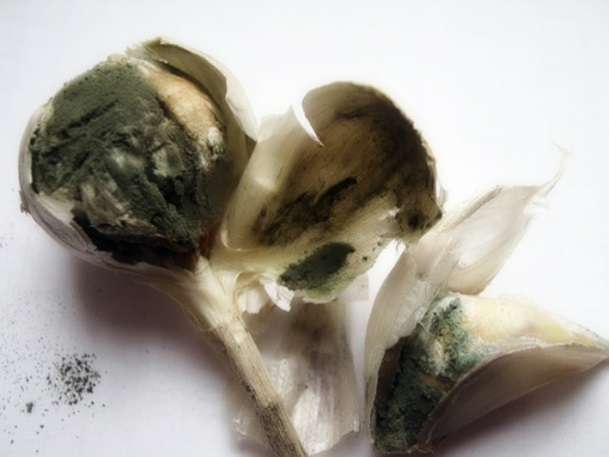
Black rot can sometimes be seen on the husk, but more often it "eats away" the teeth from the inside
Gray rot
The disease is caused by a fungus of the species Botrytis allii. In garlic, gray rot primarily affects the root collar at the soil level. The signs of fungal infection appear in the spring or early summer. The appearance of rot looks like a watery lesion on the stem.
Further, the fungus begins to sprout down to the bulb. Initially, the gray mold leaves the outer wall of the stem intact. It affects the inside, so the disease of garlic with this fungus goes unnoticed. When the head of a diseased plant is formed, the outer husk often becomes an intense purple color, which then turns into brown or black.
Predisposing factors for the development of gray rot are cool air and moist soil in spring or early summer. With the onset of heat above 30 ° C, the development of the fungus stops naturally.
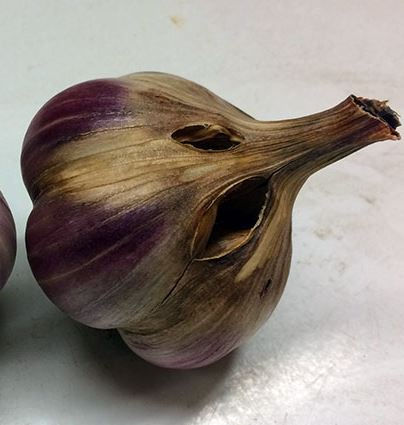
When affected by gray rot, the outer cover of the garlic head dries out and becomes very tough
Bacteriosis
Usually affects already mature bulbs during storage. Separate cloves begin to rot. Outwardly, the disease may look like only a small brown spot. But when cut, it turns out that the core is almost completely rotted. In advanced cases, bacteria "eat away" all the soft tissues of the garlic under the hard skin. The pulp of the cloves becomes glassy.
The reason is insufficient drying of the harvested crop. High humidity and air temperature contribute to the spread of putrefactive bacteria.
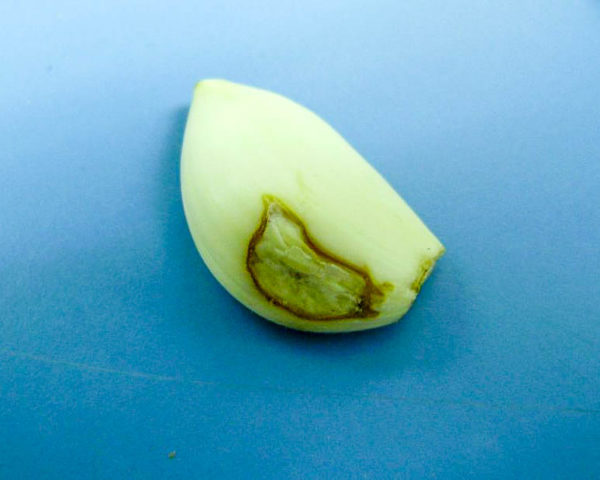
Bacterial rot is invisible until the slice is peeled off
Pests
The heads can also rot due to pests, although here it will not do without bacteria. Microorganisms penetrate into the damaged plant, and it rots. But the root cause is pests:
- onion fly;
- stem nematode;
- onion moth;
- bear;
- beetle larva.
The last three insects "specialize" in roots. They live in the ground, which makes them very difficult to destroy.
Onion fly
The larvae cause harm. The female lays eggs at the base of the leaves or under the clumps of soil next to the plant. The hatched larvae drill holes down to the bottom of the head. They feed on the pulp of the onion. Bacteria “sit down” on the damaged garlic, and it begins to rot.
Visually detected eggs at the base of the socket can be considered a sign of infection. But usually this moment is missed. The owner of the garden notices the attack of the pest even when the garlic has completely rotted.
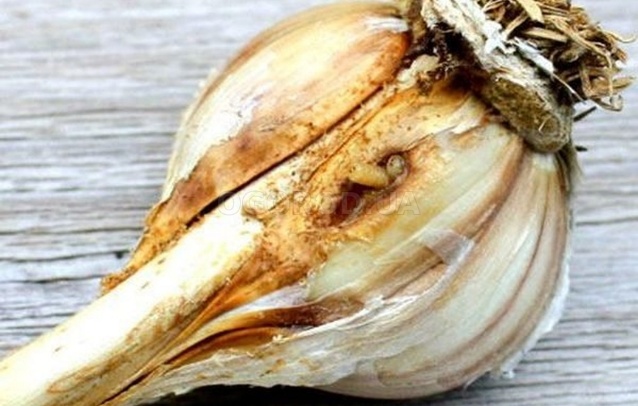
Onion fly larvae should be looked for near the bottom of the garlic head
Onion moth
This is a night moth.It departs in mid-spring and ends activity in early autumn. It lays eggs not only at the base of the rosette, but also on the underside of leaves and flower stalks. The larvae are not interested in the heads; they damage unopened inflorescences, stems and leaves. The underground part of garlic, due to the activity of pests, does not receive a sufficient amount of nutrients, stops developing and begins to rot.

This is what the aerial part of garlic looks like, damaged by the larva of an onion moth.
Stem nematode
It is a parasite that feeds only on living tissues of plants. It does not touch the roots, but damages the bulbs, stems and leaves. Garlic cloves affected by the nematode soften and rot.
The external signs of damage by a nematode and an onion moth are similar: deformation, yellowing, dying off. Although in garlic, only yellowing and leaf death are present. You can determine that the nematode is to blame if you carefully examine the bulbs. Rot is not observed with onion moth.
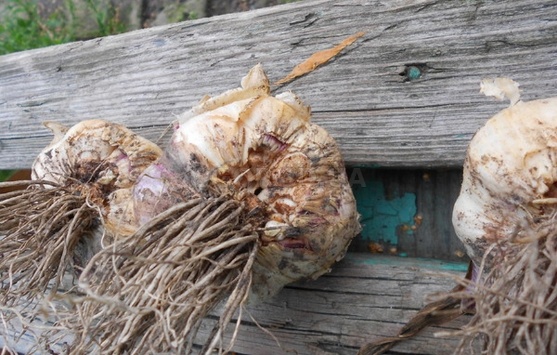
The result of the activity of the stem nematode
Medvedka and grub
These pests live underground and damage roots and bulbs. Regardless of which insect "worked" on the plant, the garlic head will rot. Khrushchev feeds on roots. Medvedka gnaws underground parts of plants while digging underground passages. Through damage, putrefactive bacteria penetrate into the bulb.
In the photo below, on the left, a bulb damaged by a bear, on the right - the roots of garlic, eaten by the larva of the May beetle

In any case, a garlic head deprived of roots dies and rots.
Why did garlic rot after harvesting
The most common cause is poor drying. Only garlic dug out of the ground has very soft and moist outer covers. Dry it until the top layer of the husk looks like parchment paper.
Another reason is early cleaning. If the heads do not have time to mature, the inner covers of each clove will remain moist and provoke rotting. This young garlic is best used for summer cooking.
Garlic rots even if stored improperly. For example, if you put it in a box. The lower heads can "suffocate" without air and begin to rot. The best way to store at home is with bundles suspended from a rope. With this method, the heads are ventilated. If there is a dry and cool cellar, the garlic can be stored in drawers. But it needs to be shifted with straw.

Trim the roots before storing to minimize the risk of rot
What to do if garlic rots in the ground
If the garlic has already begun to rot, do nothing. Just dig it up and destroy it. The processing of garlic from rot must be carried out before planting. They process not only the teeth, but also the soil.
How to treat and how to treat garlic from white rot
Measures to combat white rot on garlic can be:
- chemical;
- biological;
- thermal.
The first is the treatment of planting material and plants during the growing season with fungicides. The dosage and method of administration depend on the brand of the drug and are indicated in the instructions. Seed material is soaked in a fungicide solution before planting. Plants during the growing season are watered with the drug when signs of disease appear.
The biological method allows you to destroy the mycelium even before planting the lobules in the soil. The use of a growth stimulator for the "Diallyldisulfide" fungus is justified. This substance is used to spill the soil into which the garlic is planned to be planted. The stimulant promotes mold growth. But since the rot does not find its "owner", it dies. Use "Diallyldisulfide" at a soil temperature above 9 ° C and air temperature below 27 ° C.
The thermal method involves raising the temperature of the soil to a level at which the fungi die.If the garlic is going to be planted before winter, in the summer the selected area can be "fried". The method works well for hot regions. The ground is covered with a black film and kept for 1.5 months.

Thermally, you can warm up the soil well to get rid of the fungus that causes rot
How to treat root rot in garlic
If other fungal diseases of garlic are treatable, then there is no bottom rot. The only way to deal with fusarium is to immediately dig up and destroy the infected plants. You can prevent rot or use seeds - "air" for planting.
Fighting aspergillosis
They do not fight against black mold, since it appears already during storage. To get rid of it, they examine the heads of garlic and remove the spoiled ones.
How to get rid of gray rot on garlic
Considering that the main process of development of gray rot is imperceptible and occurs in the internal tissues of garlic, you can get rid of it only in a radical way:
- remove diseased plants;
- create good air circulation by loosening for the remaining healthy specimens;
- speed up drying when harvesting.
The latter is produced by cutting off the stems from the heads right during the harvest. Then the heads of garlic are laid out in trays in one layer.
Fight against bacteriosis
During the growing season, the plantings are inspected and, if necessary, sprayed with a 1% solution of Bordeaux liquid. The last treatment is carried out 20 days before harvesting. During harvesting, diseased heads are examined and removed.
Onion fly control
The easiest way to use industrial insecticides. In stores, you can buy a drug for every taste. The most popular drug is "Aktara". From folk remedies, plants that repel the pest are suitable:
- wormwood spread between the beds and plants;
- carrots planted interspersed with garlic.
Wormwood needs to be changed as it wilts. Since this is a wild-growing weed, it cannot be planted in the garden. Carrots should not be mixed together. Garlic requires a dry period of two weeks before harvesting, and carrots need to be watered more frequently. Therefore, these two crops are planted in strips so that the latter can be watered without touching the garlic.
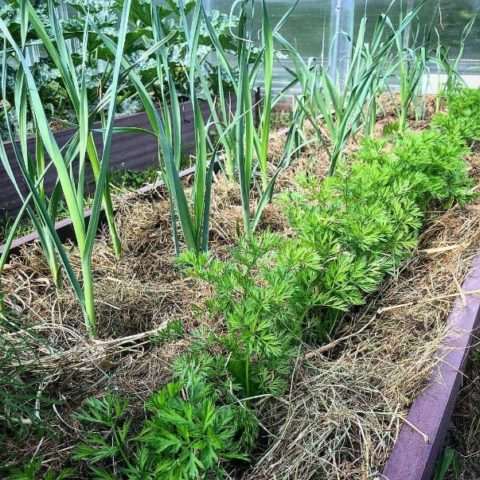
Crops planted next to each other mutually protect each other from onion and carrot flies
Methods against onion moth
From chemical - the same insecticides as against onion flies. You can reduce the number of butterflies by agrotechnical methods:
- deep plowing after harvest;
- the use of crop rotation with the return of crops to their previous place after 3-6 years;
- destruction of dry tops after harvesting;
- planting garlic in a well-ventilated area.
It is also possible to reduce the damage caused by moths in a purely mechanical way: cover the garlic overnight with a non-woven material. In the afternoon it is removed.
Stem nematode control
To combat the nematode, carbamide, ammonia water or percalcite ameliorant are added to the soil before planting the garlic. Use only healthy seed. Observe the correct temperature regime when storing garlic heads: below + 4 ° C or above + 30 ° C with low air humidity. A crop rotation period of 3-4 years is observed.
Fighting the bear and the beast
It is useless to fight with insecticides with beetle, the larvae burrow too deep into the ground. Grizzly, Medvetoks, Zolon, Thunder, Beardrops are used against the bear. These are industrial insecticides designed specifically for the destruction of bears.
But you can also use folk methods: ash and tobacco dust. These substances may be the best options. They must be applied on moist soil, that is, you can do this after watering. Further, the substances are carefully embedded in the soil. Garlic loves loose soil.To protect it from rot, it is necessary to loosen the soil after watering. Therefore, at the same time, it is possible to introduce substances that repel underground pests.
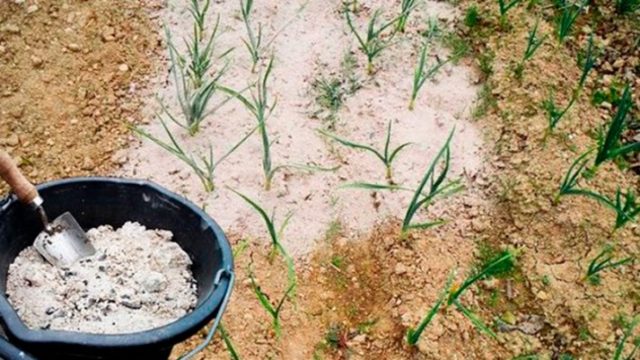
Ash brought in when loosening a bed will protect against pests and replenish nitrogen reserves in the soil
What to do to prevent garlic from rotting in the garden
Preventive measures include:
- selection of healthy seed;
- warming beds with winter garlic before cold weather;
- providing garlic with sufficient nitrogen;
- loosening the soil in the beds and weeding weeds;
- garlic is harvested only after the aerial parts dry up and lie on the ground;
- the heads are dried before storage.
The likelihood of developing gray rot is reduced by avoiding waterlogging of the soil.
The best prevention of white rot is sanitary conditions. The fungus can persist on dry surfaces for many years. Therefore, everything that was in contact with diseased plants, up to the walls of storage facilities and personnel shoes, is disinfected.
What folk remedies can be used to treat garlic from rot
Of the folk remedies for most types of rot, soaking the seed material before planting in a 1% solution of potassium permanganate is the most popular. Also, this composition is used to shed soil in the selected area.
Another way to destroy rot in the soil: an infusion of poisonous herbs. Use fresh calendula or yarrow. 50 g of chopped green mass is poured with a liter of water and infused for a week. The resulting liquid is poured into a 10-liter bucket, poured to full and the beds are watered. Processing is carried out before planting. If necessary, the procedure can be repeated during the growing season.

1% solution of potassium permanganate should be saturated color
Conclusion
If the garlic rots in the garden, in most cases it will not be possible to save the crop. The fight against fungi and bacteria must be started before planting the spice in the ground.








